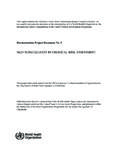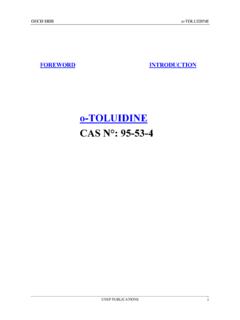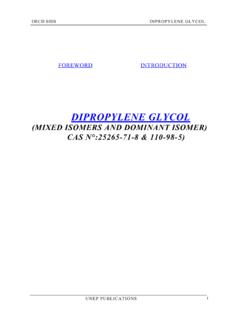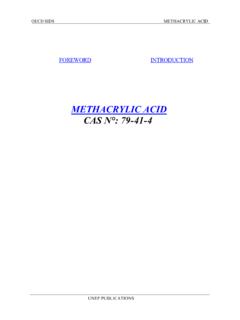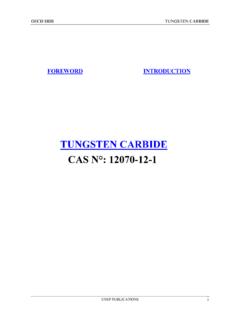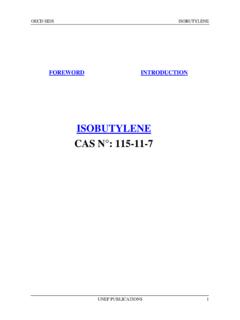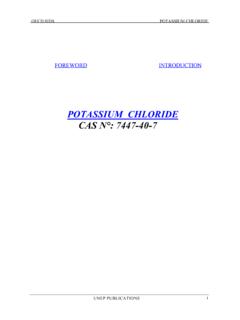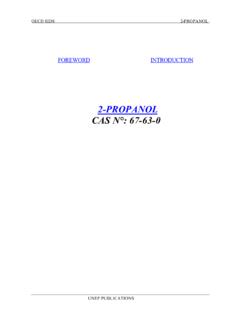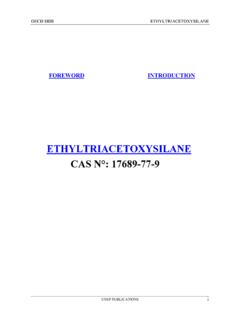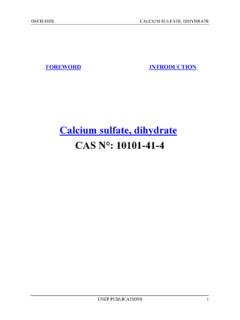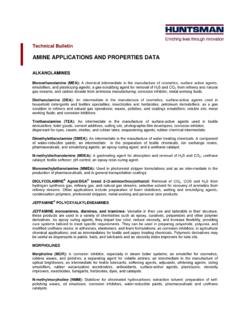Transcription of ETHYLENEDIAMINE CAS N°: 107-15-3 - inchem.org
1 OECD SIDS ETHYLENEDIAMINE . FOREWORD INTRODUCTION. ETHYLENEDIAMINE . CAS N : 107-15-3 . UNEP PUBLICATIONS 1. OECD SIDS ETHYLENEDIAMINE . SIDS INITIAL ASSESSMENT REPORT. For 13th SIAM. (Bern, Switzerland November 6 -9, 2001). Chemical Name: ETHYLENEDIAMINE CAS No.: 107-15-3 . Sponsor Country: United States/ICCA. National SIDS Contact Point in Sponsor Country (or Lead Organisation which ever is applicable): United States Environmental Protection Agency Oscar Hernandez, Director Risk Assessment Division (7403M). 1201 Constitution Ave, NW. Washington, DC 20460. e-mail: phone: 1 202-564-7641. Industry Group: Ethyleneamine Product Stewardship Discussion GROUP (EPSDG)- Attn: Lynn Bergeson Bergeson and Campbell Washington, e-mail: phone: 202-962-8577.
2 History: Documents were prepared and reviewed by industry prior to submission to sponsor country. Data searches consisted of searching available literature, databases and internal consortia files. Sponsor country conducted reviews of submitted data and offered comments to industry. It should be noted that a Concise International Chemical Assessment Document (CICAD) is available for this chemical and may be located at Industry prepared and resubmitted documents for consideration at SIAM 13. Testing: No testing (x). Testing ( ). Comments: Deadline for Circulation: September 14, 2001. Date of Circulation: 2 UNEP PUBLICATIONS. OECD SIDS ETHYLENEDIAMINE .
3 SIDS INITIAL ASSESSMENT PROFILE. CAS No. 107-15-3 . Chemical Name ETHYLENEDIAMINE Structural Formula NH2-CH2-CH2-NH2. RECOMMENDATIONS. The chemical is currently of low priority for further work. SUMMARY CONCLUSIONS OF THE SIAR. Human Health Acute toxicity of ETHYLENEDIAMINE (LD50, rat, oral range from 637 mg/kg to 1850 mg/kg; LC50, rat, inhalation >29. mg/l and LD50, rabbit, dermal 560 mg/kg) is considered to be low to moderate. Due to the high alkalinity, ETHYLENEDIAMINE is corrosive to the skin and eyes. It is a dermal and respiratory sensitizer in humans and has been reported to cross-sensitize for chemicals of similar structure. In repeat dose studies, decreased body weight along with decreased water and feed consumption were observed.
4 Every attempt was made to minimize the irritating nature of EDA and reduce the pH by using EDA-2 HCL. Hepatocellular pleomorphism was noted in every study following dietary administration of longer than 13 weeks duration. Gavage administration resulted in effects in the eyes and kidneys. Kidney effects consisted of degenerative and regenerative changes in the tubular epithelium. The Lowest-Observable-Adverse-Effect-Level (LOAEL) is 100 mg/kg/day with a No-Observable-Effect-Level (NOEL). of 20 mg/kg/day observed in the chronic dietary feeding study. ETHYLENEDIAMINE was rapidly excreted with most of the material eliminated in the urine within 24 hours.
5 ETHYLENEDIAMINE has produced weakly positive results, 2-3. times greater than control values, in several Ames tests, which may or may not be related to an impurity. Subsequent studies conducted with purer material were negative. All other tests including several in vitro assays (CHO gene mutation, sister chromatid exchange with CHO cells and UDS with primary rat hepatocytes) and a rat dominant lethal assay were negative. The weight of evidence from both in vitro and in vivo tests indicates that ETHYLENEDIAMINE is unlikely to be genotoxic. In chronic bioassays via two routes of exposure there was no carcinogenic effect. In developmental toxicity studies, growth retardation was noted at maternally toxic levels.
6 However, there was no evidence of developmental toxicity at maternally toxic doses when compared with a pair-fed control. There was no effect on reproductive parameters at levels, which produced parental toxicity. Environment ETHYLENEDIAMINE 's vapor pressure is 12hPa at 20 0C, the log Pow range is from to and the water solubility is110 g/L. It should be noted that while EDA does not have as high of a stability constant as several higher molecular weight ethyleamines, it does have the potential to chelate copper. Based on physical chemical properties, EDA is not expected to bioaccumulate. ETHYLENEDIAMINE is expected to be readily biodegradable in the environment with > 80% degraded within 28 days.
7 The estimated photodegradation half-life is hours. Using the level III. Fugacity Model by Mackay, most of EDA at steady state will partition to the water compartment. The 96 hr LC50 in fish is 115 mg/L while the 96 hr algae biomass EC50 is 61 mg/L. In the most sensitive aquatic organism, Daphnia magna, the 48 hr LC50 is 3-46 mg/L with a 21-day reproduction test No-Observable-Effect-Concentration (NOEC). of mg/L. Exposure In the United States (US), ETHYLENEDIAMINE is a major industrial chemical used primarily as a closed-system intermediate in the production of chelating agents. It is also used to produce polyamide resins, ethylene bis- stearamide, gasoline and lube oil additives and cationic surfactants.
8 Production in Western Europe is 58,000 tonnes, 41,000 tonnes in the US and 5,000 tonnes in Japan. In the US, environmental releases are not anticipated based on the manufacturing process and use conditions. Since it is primarily an industrial intermediate in the US, exposures are anticipated to be restricted to product transfer and maintenance operations. Exposures in the workplace are UNEP PUBLICATIONS 3. OECD SIDS ETHYLENEDIAMINE . typically below 10 ppm (TWA). In the , the only known use of EDA in consumer products is via the pharmaceutical industry in the production of aminophylline for the treatment of severe asthma. In the this use is regulated and restricted to consumers under medical supervision.
9 Based on varied information provided by registries from some OECD member countries (Sweden, France, Switzerland, Finland and Denmark) it would appear that the concentration of unreacted EDA in products sold to consumers is low, typically less than However, it is recommended that each OECD Member country evaluate their exposure scenarios to determine the chemical's priority for further work. NATURE OF FURTHER WORK RECOMMENDED. Based on data indicating EDA possibly being present in consumer products, national or regional exposure information gathering may need to be considered to clarify the possible extent of exposure to consumers. 4 UNEP PUBLICATIONS.
10 OECD SIDS ETHYLENEDIAMINE . FULL SIDS SUMMARY: ETHYLENEDIAMINE CAS NO: 107-15-3 SPECIES PROTOCOL RESULTS. PHYSICAL-CHEMICAL. Melting Point -- -- C. Boiling Point -- -- 17 C. Density -- -- g/cm3. Vapour Pressure -- -- 12 hPa at 20 C, hPa at 25 C. Partition Coefficient -- -- to (Log Pow). A. Water Solubility -- -- 110 g/L at 20 C. B. pH -- -- at 5 g/L. pKa -- -- pK1 pK2 Oxidation: Reduction -- -- No data Potential ENVIRONMENTAL FATE. AND PATHWAY. Photodegradation -- Calculated hours Stability in Water -- Calculated Does not contain functional groups for hydrolysis. Monitoring Data -- Measured Limited occupational air sample data, concentrations are usually below 10 ppm, the ACGIH TLV.
